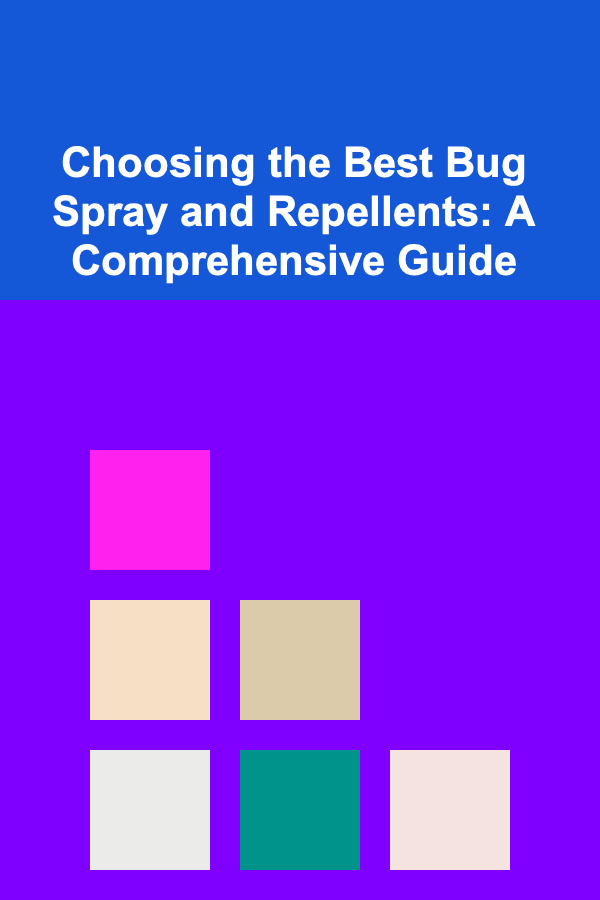
Choosing the Best Bug Spray and Repellents: A Comprehensive Guide
ebook include PDF & Audio bundle (Micro Guide)
$12.99$11.99
Limited Time Offer! Order within the next:

Spending time outdoors is one of life's greatest pleasures, whether it's hiking in the mountains, relaxing on the beach, or simply enjoying a backyard barbecue. However, the presence of pesky insects like mosquitoes, ticks, flies, and gnats can quickly turn a pleasant experience into a frustrating one. Choosing the right bug spray or repellent is crucial for protecting yourself and your family from bites, stings, and the potential diseases they carry. This comprehensive guide will delve into the science behind insect repellents, explore the various types available, provide expert advice on selecting the best option for your needs, and offer tips for safe and effective application.
Understanding Insect Repellents: How They Work
The effectiveness of insect repellents hinges on their ability to interfere with an insect's sensory perception, making it difficult for them to locate and bite their target. While the precise mechanisms vary depending on the active ingredient, most repellents work by creating a vapor barrier that insects find aversive. This barrier essentially masks the human scent, preventing insects from detecting the carbon dioxide, body odor, and other attractants that typically lead them to their next meal. It's important to understand that most repellents don't actually "kill" insects; they simply deter them from landing on or biting you.
Key Active Ingredients in Insect Repellents
Several active ingredients are commonly used in insect repellents, each with its own strengths, weaknesses, and safety considerations. Understanding these differences is essential for making an informed choice.
- DEET (N,N-Diethyl-meta-toluamide): DEET has been the gold standard in insect repellents for decades, and for good reason. It's highly effective against a wide range of biting insects, including mosquitoes, ticks, fleas, and biting flies. DEET works by interfering with the insect's ability to smell human attractants. Concentrations typically range from 5% to 100%, with higher concentrations offering longer-lasting protection. However, higher concentrations also increase the risk of skin irritation and should be used judiciously, especially on children. The American Academy of Pediatrics recommends using products containing no more than 30% DEET on children over 2 months of age. Concerns about DEET's safety are often overblown; decades of research have shown that it is safe when used as directed.
- Picaridin (Icaridin): Picaridin is a synthetic repellent that is effective against mosquitoes, ticks, and biting flies. It's often considered a good alternative to DEET, as it's less likely to irritate the skin and doesn't have the same strong odor. Picaridin is also less likely to damage plastics and synthetic fabrics, making it a more practical choice for clothing and gear. Concentrations typically range from 5% to 20%. Studies have shown that picaridin is as effective as DEET at similar concentrations, offering comparable protection against mosquito bites.
- Oil of Lemon Eucalyptus (OLE) / PMD (p-Menthane-3,8-diol): OLE is a plant-based repellent derived from the lemon eucalyptus tree. It's a natural alternative to DEET and picaridin, and is effective against mosquitoes and ticks. PMD is the active component within OLE that provides the repellent properties. However, it's crucial to distinguish between OLE and lemon eucalyptus essential oil, which is not an effective insect repellent. OLE products typically contain around 30% PMD and offer protection comparable to low concentrations of DEET. The CDC recommends OLE as an effective and safe alternative to DEET and picaridin for adults and children over the age of 3.
- IR3535 (Ethyl butylacetylaminopropionate): IR3535 is another synthetic repellent that is generally considered safe and effective. It's less effective than DEET and picaridin against some insects, particularly ticks, but it can provide good protection against mosquitoes and biting flies. IR3535 is often found in repellents marketed for children, as it is less likely to cause skin irritation. It is often combined with other ingredients to enhance its effectiveness.
- Essential Oils (Citronella, Lavender, Peppermint, etc.): While many essential oils are marketed as natural insect repellents, their effectiveness is often limited and short-lived compared to DEET, picaridin, and OLE. Citronella is perhaps the most well-known essential oil repellent, but its protection typically lasts for only a short period (30 minutes to 2 hours) and may not be effective against all types of insects. Furthermore, essential oils can cause allergic reactions in some individuals, and should be tested on a small area of skin before widespread use. While these oils may offer some degree of repellency, they are generally not recommended as the sole form of protection in areas with high insect populations or a risk of insect-borne diseases. Their primary use is more suited to aromatherapy or very short periods of outdoor activity where exposure is minimal.
Factors to Consider When Choosing a Bug Spray
Selecting the right bug spray or repellent involves considering several factors, including the type of insects you're trying to repel, the duration of protection you need, your personal preferences, and any potential safety concerns.
Target Insect Species
Different repellents are more effective against certain types of insects. For example, DEET and picaridin are generally considered effective against a wide range of insects, including mosquitoes, ticks, fleas, and biting flies. OLE is also effective against mosquitoes and ticks. However, some essential oil-based repellents may only be effective against mosquitoes and not against ticks. If you're traveling to an area known for specific insect-borne diseases (e.g., Lyme disease carried by ticks, Zika virus carried by mosquitoes), it's crucial to choose a repellent that is proven to be effective against those particular insects.
Duration of Protection
The duration of protection offered by a repellent depends on the active ingredient, its concentration, and environmental factors such as temperature and humidity. Higher concentrations of DEET and picaridin typically provide longer-lasting protection. Sweating and exposure to water can also reduce the effectiveness of repellents. If you're spending a long time outdoors, you may need to reapply the repellent periodically to maintain protection. Always follow the manufacturer's instructions for reapplication.
Personal Preferences and Sensitivities
Some people are sensitive to certain ingredients in insect repellents, such as DEET. If you have sensitive skin or a history of allergic reactions, consider choosing a repellent with a lower concentration of active ingredients or opting for a DEET-free alternative like picaridin or OLE. The smell of some repellents can also be a factor; some people find the odor of DEET unpleasant, while others prefer the scent of citronella. Consider trying different products to find one that you find tolerable.
Activity Level and Environmental Conditions
Your activity level and the environmental conditions can also influence your choice of repellent. If you're engaged in strenuous activity that causes you to sweat heavily, you may need to reapply the repellent more frequently. Humid conditions can also reduce the effectiveness of some repellents. If you're going to be near water (e.g., swimming, boating), choose a water-resistant or waterproof repellent.
Age and Pregnancy
Certain repellents are not recommended for use on young children or pregnant women. The American Academy of Pediatrics recommends using products containing no more than 30% DEET on children over 2 months of age. OLE is generally considered safe for children over 3 years of age. Consult with your pediatrician or healthcare provider for specific recommendations regarding the use of insect repellents on children. Pregnant women should also consult with their healthcare provider before using any insect repellent, especially those containing DEET. While DEET is generally considered safe for pregnant women when used as directed, some women may prefer to use a DEET-free alternative like picaridin or OLE.
Types of Insect Repellents
Insect repellents come in various forms, each with its own advantages and disadvantages.
Aerosol Sprays
Aerosol sprays are convenient and easy to apply, covering a large area quickly. However, they can be wasteful and may not provide as even a coating as other types of repellents. It's important to apply aerosol sprays in a well-ventilated area and avoid inhaling the spray.
Pump Sprays
Pump sprays are a more environmentally friendly alternative to aerosol sprays. They provide more control over the application and are less likely to be wasted. However, they may require more effort to apply evenly, especially to hard-to-reach areas.
Lotions and Creams
Lotions and creams provide a more targeted application and are less likely to be inhaled than sprays. They are also less likely to drip or run. However, they can be more difficult to apply evenly, especially to large areas. Lotions and creams are a good option for people with sensitive skin, as they are less likely to cause irritation.
Wipes
Wipes are a convenient and portable option for applying insect repellent. They are easy to use and provide a targeted application. However, they may not cover as large an area as sprays or lotions, and they can be more expensive per application.
Wristbands and Clip-Ons
Wristbands and clip-ons that release insect repellent are a popular option, especially for children. However, their effectiveness is often limited, as they only provide protection in the immediate vicinity of the band or clip. They may not be sufficient for protecting against bites in areas with high insect populations. Furthermore, some wristbands and clip-ons contain essential oils that can cause allergic reactions. The EPA has specific regulations regarding the claims made about these devices, and many have been found to be ineffective. It's important to look for products that have been tested and proven to be effective.
Candles and Torches
Citronella candles and torches can help to repel mosquitoes in outdoor areas. However, their effectiveness is limited to the immediate vicinity of the candle or torch, and they may not be sufficient for protecting against bites in larger areas. They also pose a fire hazard and should be used with caution.
Safe and Effective Application of Insect Repellents
Applying insect repellent correctly is crucial for maximizing its effectiveness and minimizing any potential risks.
Read the Label Carefully
Always read and follow the manufacturer's instructions on the product label. Pay attention to the recommended application frequency, concentration, and any warnings or precautions.
Apply to Exposed Skin
Apply insect repellent only to exposed skin. Do not apply it under clothing, as this can increase the risk of skin irritation. If you're using sunscreen, apply the sunscreen first and then apply the insect repellent.
Avoid Contact with Eyes and Mouth
Avoid getting insect repellent in your eyes, mouth, or open wounds. If you do, rinse immediately with water.
Use Sparingly on Children
When applying insect repellent to children, use it sparingly and avoid applying it to their hands, as they may put their hands in their mouths. Do not apply repellent to children under 2 months of age. Instead, use mosquito netting to protect them from bites.
Apply in a Well-Ventilated Area
Apply insect repellent in a well-ventilated area to avoid inhaling the spray. If you're using an aerosol spray, hold the can about 6-8 inches away from your skin and spray evenly.
Wash Hands After Application
Wash your hands with soap and water after applying insect repellent. This will help to prevent you from accidentally ingesting the repellent or transferring it to your eyes or mouth.
Wash Treated Clothing
Wash treated clothing before wearing it again. This will help to remove any residual repellent that could irritate your skin.
Avoid Overapplication
Applying more repellent than necessary does not increase its effectiveness and can increase the risk of skin irritation. Use just enough repellent to cover exposed skin lightly.
Beyond Repellents: Additional Strategies for Insect Bite Prevention
While insect repellents are a crucial tool in preventing bites, they are not the only line of defense. Incorporating other strategies can significantly reduce your risk of being bitten.
Wear Protective Clothing
Wearing long-sleeved shirts, long pants, socks, and a hat can help to protect your skin from insect bites. Light-colored clothing is less attractive to mosquitoes than dark-colored clothing. Consider treating clothing with permethrin, an insecticide that repels and kills insects. Permethrin-treated clothing can provide long-lasting protection, even after multiple washes. However, permethrin should not be applied directly to the skin.
Avoid Peak Insect Activity Times
Mosquitoes are most active at dawn and dusk. If possible, avoid being outdoors during these times. If you must be outdoors during peak mosquito activity, take extra precautions to protect yourself from bites.
Maintain Your Yard
Eliminate standing water around your home to prevent mosquitoes from breeding. Empty flower pots, bird baths, and other containers that can collect water. Trim shrubs and mow your lawn regularly to reduce mosquito hiding places.
Use Mosquito Netting
Mosquito netting can be used to protect yourself from bites while sleeping or relaxing outdoors. Netting is particularly useful for protecting infants and young children who cannot use insect repellents.
Install Screens on Windows and Doors
Install screens on windows and doors to keep insects out of your home. Make sure the screens are in good repair and fit tightly to prevent insects from entering.
Use Fans
Fans can help to repel mosquitoes by creating a breeze that makes it difficult for them to fly and find their targets. Place fans strategically in outdoor areas to create a mosquito-free zone.
Debunking Common Myths About Insect Repellents
Many misconceptions surround insect repellents. Addressing these myths can help you make informed decisions and use repellents effectively.
- Myth: Higher concentrations of DEET are always better. Fact: While higher concentrations of DEET provide longer-lasting protection, they don't necessarily offer better protection. Higher concentrations also increase the risk of skin irritation. Choose a concentration that is appropriate for the duration of time you'll be outdoors.
- Myth: Natural repellents are always safer than synthetic repellents. Fact: While natural repellents may be appealing to some, they are not always safer or more effective than synthetic repellents. Some essential oils can cause allergic reactions, and their effectiveness is often limited. DEET and picaridin have been extensively studied and are considered safe when used as directed.
- Myth: Repellents kill insects. Fact: Most repellents do not kill insects. They simply deter them from landing on or biting you.
- Myth: You can't use DEET on children. Fact: The American Academy of Pediatrics recommends using products containing no more than 30% DEET on children over 2 months of age. Use it sparingly and avoid applying it to their hands.
- Myth: Eating garlic or taking vitamin B12 repels insects. Fact: There is no scientific evidence to support the claim that eating garlic or taking vitamin B12 repels insects.
Conclusion
Choosing the best bug spray or repellent requires careful consideration of several factors, including the target insect species, the duration of protection you need, your personal preferences, and any potential safety concerns. By understanding the different types of repellents available, their active ingredients, and how to apply them safely and effectively, you can protect yourself and your family from insect bites and the diseases they carry. Remember to supplement repellent use with other preventive measures, such as wearing protective clothing, avoiding peak insect activity times, and maintaining your yard. Armed with this knowledge, you can confidently enjoy the outdoors without the annoyance and risks associated with insect bites.

How to Highlight Your Home's Best Features with Strategic Staging
Read More
How to Make Money Online as a Loan Officer: 10 Actionable Ideas
Read More
The Ultimate Guide to DIY Natural Cleaning Products for a Healthier Home
Read More
How to Reduce Cholesterol Naturally with Food
Read More
How to Analyze the Performance of a Child Actor
Read MoreVendor Payment Tracker: Best Practices for Data Security and Compliance
Read MoreOther Products

How to Highlight Your Home's Best Features with Strategic Staging
Read More
How to Make Money Online as a Loan Officer: 10 Actionable Ideas
Read More
The Ultimate Guide to DIY Natural Cleaning Products for a Healthier Home
Read More
How to Reduce Cholesterol Naturally with Food
Read More